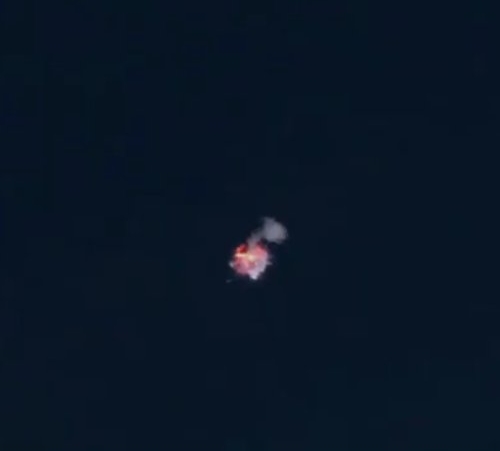Debris from Firefly launch rains down near launch spectators

Screen capture of explosion from Everyday Astronaut live stream.
When the range officer was forced to terminate the first launch of Firefly’s Alpha rocket on September 2, 2021, the subsequent explosion caused some of the debris to apparently fall near the spectators who had come out to see the launch.
Spectators who gathered across the Central Coast to watch the launch of Firefly Aerospace’s Alpha rocket — a privately designed, unmanned rocket built to carry satellites — instead saw it explode midair and debris rain down on nearby areas.
“I saw this thing floating down from the sky … then another piece, then another, and then hundreds of pieces varying in size were falling,” said Mike Hecker, a resident of Solvang who was out mountain biking in the Orcutt Hills with a large group of friends. “It was surreal to have rocket debris raining down on you,” he said.
According to all reports, it appears no one was injured or even came close to getting hurt.
We need to accept such things if we wish to do great things. The range officer destroyed the rocket to make sure it did not fly in one piece into anything on the ground, something that would have certainly caused great harm. Blowing it up prevented that, though it resulted in a small risk that smaller pieces might hit something.
Once, a story like this would have been intriguing but would have bothered no one. In today’s culture — which attempts to give everyone a “safe space” even from dissenting opinions — I fear that we shall find greater restrictions soon placed on launches.

Screen capture of explosion from Everyday Astronaut live stream.
When the range officer was forced to terminate the first launch of Firefly’s Alpha rocket on September 2, 2021, the subsequent explosion caused some of the debris to apparently fall near the spectators who had come out to see the launch.
Spectators who gathered across the Central Coast to watch the launch of Firefly Aerospace’s Alpha rocket — a privately designed, unmanned rocket built to carry satellites — instead saw it explode midair and debris rain down on nearby areas.
“I saw this thing floating down from the sky … then another piece, then another, and then hundreds of pieces varying in size were falling,” said Mike Hecker, a resident of Solvang who was out mountain biking in the Orcutt Hills with a large group of friends. “It was surreal to have rocket debris raining down on you,” he said.
According to all reports, it appears no one was injured or even came close to getting hurt.
We need to accept such things if we wish to do great things. The range officer destroyed the rocket to make sure it did not fly in one piece into anything on the ground, something that would have certainly caused great harm. Blowing it up prevented that, though it resulted in a small risk that smaller pieces might hit something.
Once, a story like this would have been intriguing but would have bothered no one. In today’s culture — which attempts to give everyone a “safe space” even from dissenting opinions — I fear that we shall find greater restrictions soon placed on launches.
